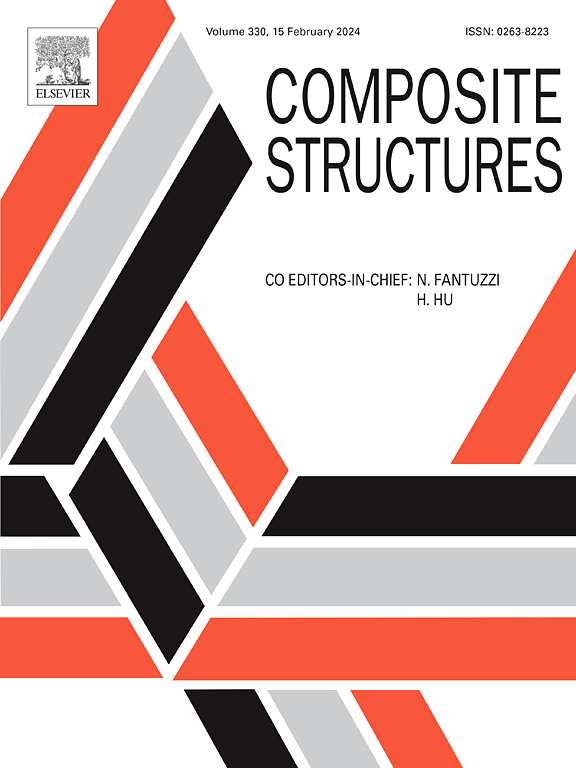用于宽带吸声通风的反设计多功能超材料
IF 6.3
2区 材料科学
Q1 MATERIALS SCIENCE, COMPOSITES
引用次数: 0
摘要
多功能声学超材料的最新进展突出了对具有通风功能的宽带吸声的需求。本研究介绍了一种多阶盘绕通道与多孔材料(MCCPM)设计,该设计将多阶腔共振与多孔材料的粘热耗散相结合,以提高在宽频率范围内的吸收效率,同时实现空气通风。MCCPM系统在多孔材料类型、入射角、温度和通风面积比的变化中都表现出强大的吸收效率。为了优化设计过程,引入了一种采用遗传算法(GA)控制的深度神经网络(DNN)模型的反设计方法,与传统有限元法(FEM)相比,计算效率提高了4000倍。通过指定所需的吸收频率范围和物理约束,混合DNN-GA方法生成了加权优化的MCCPM结构,实现了令人印象印象的性能指标:平均吸声系数为0.76、0.81和0.77,相应的半吸收带宽比率分别为79.5%、100%和89.3%,适用于200 - 600hz、600 - 1000hz和300 - 1000hz的定制频率范围。这种基于深度学习的逆向设计方法为多功能超材料研究的突破铺平了道路,为噪声控制、通风系统和可持续建筑技术的应用提供了新的途径。本文章由计算机程序翻译,如有差异,请以英文原文为准。
Inverse-designed multifunctional metamaterials for broadband acoustic absorption and ventilation
Recent advances in multifunctional acoustic metamaterials have highlighted the need for broadband sound absorption with ventilation functionality. This study introduces a Multi-order Coiled-up Channels lined with Porous Material (MCCPM) design, which integrates multi-order cavity resonances with viscous-thermal dissipation of porous materials to enhance absorption efficiency across a wide frequency range while enabling air ventilation. MCCPM system demonstrates robust absorption efficiency across variations in porous material type, incident angle, temperature and ventilation area ratio. To optimize the design process, an inverse design method is introduced, employing a Genetic Algorithm (GA)-controlled Deep Neural Network (DNN) model, which achieves a 4000-fold improvement in computational efficiency compared to traditional finite element method (FEM). By specifying the desired absorption frequency range and physical constraints, the hybrid DNN-GA approach generates weighted-optimized MCCPM structures that achieve impressive performance metrics: average sound absorption coefficients of 0.76, 0.81, and 0.77, with corresponding half-absorption bandwidth ratios of 79.5 %, 100 %, and 89.3 % across customized frequency ranges of 200–600 Hz, 600–1000 Hz, and 300–1000 Hz, respectively. This deep learning-based inverse design approach paving the way for breakthroughs in multifunctional metamaterials research, offering new avenues for applications in noise control, ventilation systems, and sustainable building technologies.
求助全文
通过发布文献求助,成功后即可免费获取论文全文。
去求助
来源期刊

Composite Structures
工程技术-材料科学:复合
CiteScore
12.00
自引率
12.70%
发文量
1246
审稿时长
78 days
期刊介绍:
The past few decades have seen outstanding advances in the use of composite materials in structural applications. There can be little doubt that, within engineering circles, composites have revolutionised traditional design concepts and made possible an unparalleled range of new and exciting possibilities as viable materials for construction. Composite Structures, an International Journal, disseminates knowledge between users, manufacturers, designers and researchers involved in structures or structural components manufactured using composite materials.
The journal publishes papers which contribute to knowledge in the use of composite materials in engineering structures. Papers deal with design, research and development studies, experimental investigations, theoretical analysis and fabrication techniques relevant to the application of composites in load-bearing components for assemblies, ranging from individual components such as plates and shells to complete composite structures.
 求助内容:
求助内容: 应助结果提醒方式:
应助结果提醒方式:


